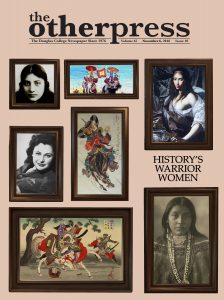Warrior women throughout history
By Brittney MacDonald, Life & Style Editor
When we look at the broad strokes of history, it is not uncommon for us to be apprised of the great dealings of legendary epic heroes—most of which happen to be male. What of the women, though? Did they simply stay home and leave the fighting to the men? As any historian will tell you, of course not! Besides well-known Catholic saint Joan of Arc, warrior women are rife throughout history, everywhere from the ancient world to the resistance fighters and spies of the 20th century. The trick is just knowing where to look.
Artemisia I of Caria
Nationality: Greek
Role: Naval commander
Lived: During the fifth century, around 480 BC
This queen is probably best known from actress Eva Green’s portrayal of her in the film 300: Rise of an Empire—which was derived from Frank Miller’s graphic novel Xerxes: The Fall of the House of Darius and the Rise of Alexander. Artemisia was an actual person and like in the movie, she was considered a brilliant naval commander.
Artemisia was queen of the Greek city-state Halicarnassus and the islands of Kos, Nisyros, and Kalymnos. Beyond her battle history, little else is known of her—she lived during the fifth century and became ruler after her husband’s death. During the second Persian invasion, Artemisia allied with Persian king Xerxes against the allied but independent Greek city-states. In 480 BC, Artemisia was the only one among Xerxes’ confidants who opposed the Battle of Salamis, an ill-fated naval battle that pitted the Persian fleet against the more powerful Greek fleet. She escaped the battle by ordering her ships to fly Greek colours and begin attacking Persian vessels—allegedly ones belonging to allies Egypt, Cyprus, Cilicia, and Pamphylia, whom she claimed were useless and whom Xerxes needed to be wary of. Upon her return to Xerxes, she garnered greater reputation for having correctly predicted many crucial aspects of the battle.
The Trưng sisters
Nationality: Vietnamese
Role: National heroines of Vietnam
Lived: c. 12 AD to 43 AD
The Trưng sisters hailed from Nanyue, a kingdom in Vietnam that was controlled by the occupying Chinese Han Dynasty. Consisting of Trưng Trắc and Trưng Nhị, their father was a prefect of the district of Mê Linh, so the sisters were highly educated in both literature and martial arts.
The elder sister, Trưng Trắc, married Thi Sách, a neighboring prefect’s son. However, Thi Sách was later executed by the governor of Jiaozhi after he attempted to resist Chinese cultural assimilation within his domain. After Thi Sách’s death, the Trưng sisters enacted vengeance by amassing a large army of mostly women and leading them in a revolt. In a short few months they had reclaimed approximately 65 citadels and freed Nanyue of Chinese occupation. Trưng Trắc was declared queen regent with Trưng Nhị as vicereine, and they ruled for three prosperous years before they were defeated by Chinese commander Ma Yuan in 43 AD. Both sisters were either executed shortly after their defeat or they died during the battle—historical accounts vary.
Tomoe Gozen
Nationality: Japanese
Role: Samurai warrior
Lived: c. 1157 AD to 1247 AD
Tomoe Gozen was a mysterious female samurai who served the samurai general Minamoto no Yoshinaka. It is highly suspected that she was either his wife or lover, but factual accounts differ. Tomoe’s aid, and that of her two brothers, was instrumental in Yoshinaka conquering Kyoto and driving out the Japanese Taira Clan, a warring clan of samurai. During the Battle of Awazu—where Yoshinaka failed to wrestle control of the Minamoto Clan from his cousin and was subsequently killed—Tomoe Gozen supposedly escaped capture by beheading Uchida Ieyoshi, a samurai serving her enemy.
What happened afterward is a little hazy. The Heike Monogatari, a text documenting the feud between the Taira and Minamoto clans, does not state what became of her after. Other historical accounts claim that she was captured and became the concubine of Wada Yoshimori. Supposedly Wada and the son she bore him were killed in 1213 by the Hojo Clan. After their deaths, Tomoe Gozen retired to become a nun and lived to be 91.
Khutulun
Nationality: Mongolian
Role: Wrestling princess
Lived: c. 1260 AD to 1306 AD
A descendant of Genghis Khan, Khutulun wasn’t known for her military prowess, unlike most of the women on this list. However, she did accompany her father, Kaidu, on many of his military campaigns as an advisor. Described as incredibly beautiful by the likes of men like Marco Polo, Khutulun was also an accomplished wrestler. She was so good that she had a standing bet against anyone willing to challenge her. If they defeated her, then she would marry them—if she won, then they would have to pay her 100 horses. Khutulun never lost the wager, accumulating a vast herd of over 10,000 horses before she eventually married—possibly for love, possibly for politics, but sources agree it wasn’t for losing a wrestling match.
Lozen
Nationality: American
Role: Apache spiritual leader
Lived: c. 1840 AD to 1889 AD
Lozen was a member of the Chiricahua Apache and sister to Chihenne Chief Victorio. Victorio claimed her as his right hand and second-in-command. He praised her as a decidedly intelligent military strategist—she was said to have had a supernatural ability to predict the movements of the enemy. She served Victorio in his marauding campaign to reclaim parts of New Mexico, near Black Mountain, from occupying US and Mexican forces.
After Victorio’s defeat and death, Lozen joined Geronimo and even attempted to negotiate peace. However, after Geronimo’s surrender she was imprisoned in Florida, then Alabama, and like many of the Apache leaders she died of illness during her confinement.
The White Mouse
Nationality: Australian
Role: Super spy
Lived: 1912 AD to 2011 AD
The White Mouse, more commonly known as Nancy Wake, was the wife of French industrialist Henri Edmond Fiocca. Apparently, after witnessing the atrocities committed by the Nazis, Wake joined the French resistance and became a key member of the Maquis groups—French guerilla forces. She was dubbed “the White Mouse” by German soldiers for her ability to evade capture by the Gestapo. Eventually Wake was forced to flee France, having accumulated a price on her head of over five million francs, making her the Gestapo’s most wanted person in the Marseilles area. She left behind her husband, at his insistence, who was later tortured and killed in her stead.
Wake escaped to Britain, where she became a member of the Special Operations Executive (SOE)—a British organization during World War II that specialized in espionage, sabotage, and reconnaissance. She began acting as a liaison between the Maquis groups and British intelligence. Her role was that of recruitment for the Maquis, as well as smuggling in weapons and other necessities. Wake facilitated the transmission of key information between the French forces and London, at times risking her own life to ensure the Allies were well appraised of every minute detail.
Her dedication and resolve earned her many medals and accolades, making her one of the most decorated servicewomen of World War II.
Noor Inayat Khan
Nationality: Indo-American descent, but raised in various parts of Europe
Role: British Muslim war heroine
Lived: 1914 AD to 1944 AD
It seems a little unfair to choose two of the SOE’s finest, but both women were so incredible I couldn’t decide. Khan also served during World War II and aided the Allies in the French resistance effort, operating under the callsign of “Nurse.”
She was a member of the Women’s Auxiliary Air Force, where she was trained as a wireless operator (radio transmission) and was assigned to aid a bomber training school. However, she found the work dull and later applied for a different commission. She was then recruited into the SOE, who modified her training as a wireless operator to include field work in an occupied territory. It was dangerous work. Wireless operators were imperative to the organized resistance effort, but they were also incredibly vulnerable to detection because they were at the centre of every information hub. Owing to the success of female couriers behind enemy lines, military superiors decided to smuggle female wireless operators into France, since they would be less suspicious to Nazi forces. Khan became the first female operator sent to Gestapo-occupied France.
After serving in France for four months, Khan was betrayed—either by double agent Henri Déricourt or because of a romantic spat involving other British operatives. Khan was captured and interrogated by German agents for close to a year, but apparently never gave them any information pertaining to her work or her fellow operatives.
In 1958 a former Dutch prisoner of the Schutzstaffel (SS), who wished to remain anonymous, revealed that Khan was beaten and then shot by Wilhelm Ruppert—an SS soldier who presided over executions at Dachau concentration camp.
Khan was awarded the George Cross and the Croix de Guerre posthumously. A bust of her was erected in central London, near her former family home. Her name also appears at the First Aid Nursing Yeomanry War Memorial at St. Paul’s Church in Wilton Place, London.



